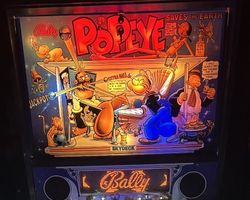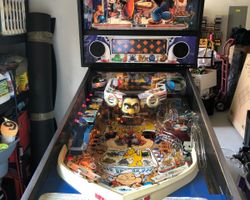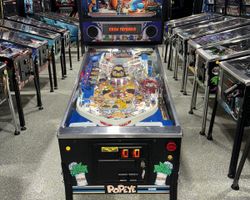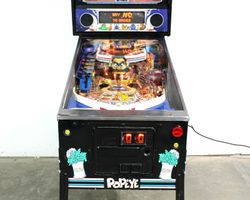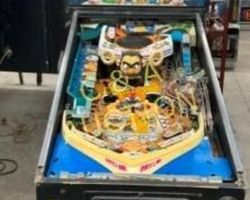Popeye Saves the Earth
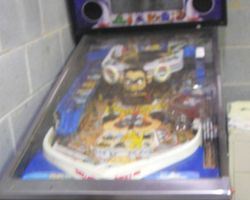
Average Prices: USD $700 to $2,300
Produced: Febuary, 1994
Production Run: 4,217 units
Machine Type: Solid State Electronic
MPU: Williams WPC (DCS)
Players: 4
Design by: Barry Oursler, Python Anghelo
Art by: John Youssi, Pat McMahon, Python Anghelo
Music by: Paul Heitsch
Sound by: Paul Heitsch
Software by: Mike Boon
Popeye Saves the Earth, released by Bally Manufacturing Co. in February 1994, emerged as a distinct entry in the WPC (DCS) generation of pinball machines. This widebody title took inspiration from the classic Popeye cartoon character, but overlaid it with an environmental narrative. The machine was conceived during a period of innovation at Bally, seeking to blend established intellectual property with contemporary themes.
The design team behind Popeye Saves the Earth was a collaborative effort. Barry Oursler and Python Anghelo helmed the game design, aiming to translate Popeye's world into an interactive pinball experience. John Youssi, Pat McMahon, and Python Anghelo crafted the distinctive artwork, imbuing the playfield and cabinet with vibrant colors characteristic of the animated series. The auditory landscape was shaped by Paul Heitsch, responsible for the music and sound design, while Tim Kitzrow provided custom callouts, lending his voice to Popeye. Software development was handled by Mike Boon, with Eugene Geer and Scott Slomiany contributing to the Dot Matrix Display (DMD) animations. Zofia Bil managed the mechanical aspects, ensuring the intricate physical features functioned as intended. With a production run of 4,217 units, model number 50022, Popeye Saves the Earth was marketed with slogans such as "A magnifisink new pinball from Bally" and "I yam armed and ready to save the planek!", highlighting its thematic blend of nautical adventure and ecological responsibility.
Signature Features and Design
Popeye Saves the Earth distinguishes itself with several unique elements that define its aesthetic and gameplay. As a widebody pinball machine, it offered a larger canvas for designers, allowing for a more expansive and multi-leveled playfield layout than standard machines. This additional space facilitated the integration of prominent toys and mechanisms. A central feature is the interactive Bluto head, serving as a physical ball lock for initiating multiball modes. This mechanism is visually engaging and directly tied to progression.
Another notable design element is the boat-shaped playfield, a clever artistic interpretation that reinforces the Popeye theme. The Animal Ramp and a specialized Skill Shot Wheel are integral components that are immediately noticeable upon first glance. The machine also incorporates spinning discs, adding an element of unpredictability to ball movement, and features extensive custom speech from Popeye, adding character and narrative depth. The vibrant, colorful artwork by John Youssi, Pat McMahon, and Python Anghelo contributes significantly to the machine's identity, making it visually striking and consistent with the cartoon's style. These elements collectively contribute to an immersive experience, inviting players into Popeye's world to tackle the environmental challenges presented.
Playfield and Mechanics
The playfield of Popeye Saves the Earth is a complex and highly detailed environment, leveraging its widebody design to create a multi-leveled experience. The lower playfield features four flippers, three pop bumpers, and two slingshots, providing a foundation for core pinball action. Two distinct ramps guide the ball to different areas of the playfield, including the Animal Ramp, which visually connects to the game's theme of saving various creatures.
The upper playfield is a significant design choice, introducing a layer of complexity to ball trajectories and shot opportunities. The primary objective on the playfield revolves around interacting with these elements to progress through environmental missions. The Bluto head mechanism is strategically placed for ball locking, often requiring precise shots to activate multiball sequences. The Skill Shot Wheel at the plunge offers an immediate challenge, rewarding accurate initial ball launches. Artwork across the playfield is meticulously integrated, with detailed illustrations of Popeye characters and environmental hazards. Lighting is used to guide players, highlighting active shots and modes. The overall aesthetic aims to draw players into the world, despite some challenges posed by the multi-layered layout. The design philosophy behind this layout appears to be an attempt to offer depth and multiple strategic paths, pushing players to explore different areas of the expansive playfield.
Gameplay Dynamics
The gameplay dynamics of Popeye Saves the Earth are centered around a progressive system of environmental missions and multi-ball play. The core objective is to "Save the Earth" by completing various tasks, often involving specific shot sequences or interactions with playfield elements like the Animal Ramp. The machine features a layered multiball system, offering three distinct modes: a 3-ball, a 4-ball, and a climactic 6-ball multiball. Achieving the 6-ball multiball is a primary game highlight, creating a chaotic and high-scoring scenario that challenges a player's ball control.
Progression typically involves activating modes by hitting specific targets or ramps, which then illuminate objectives to advance the "Save the Earth" narrative. For instance, players might need to hit certain shots to clean up pollution or rescue endangered animals. The Swee'Pea Video Mode offers a departure from traditional pinball action, presenting a unique challenge on the Dot Matrix Display. Mastering the distinct shot angles required for each of the two ramps, understanding the logic behind the Bluto ball lock, and effectively managing the various multiball opportunities are crucial player strategies. The machine's extensive custom speech and thematic sound package serve to reinforce these objectives, providing audio cues and encouragement as players navigate the complex rule set.
Reception and Legacy
Popeye Saves the Earth elicited a notably divided reception within the pinball community, showcasing both its ambitious design and some of its inherent challenges. On the positive side, many enthusiasts praised the vibrant, colorful artwork, which successfully captured the essence of the Popeye cartoon. The boat-shaped playfield design was frequently cited as a creative and unique aesthetic choice. For players who engaged with its deeper mechanics, the game offered a challenging and rewarding experience with a complex rule set, particularly the excitement of its layered multiball modes, culminating in the impressive 6-ball sequence. The Bluto head mechanism and the presence of an upper playfield were also seen as unique toys and features that added character and depth. Many also considered it a good value acquisition due to its polarized reputation, often found at accessible price points. The sound package, especially Tim Kitzrow's callouts for Popeye, contributed positively to the game's atmosphere for some players.
However, the machine also faced significant criticism. A prominent point of contention was the playfield layout, particularly the upper playfield's tendency to obstruct views of the lower area. This design choice often led to frustrating shots and a perception of a cramped playfield, making ball tracking difficult. The "Save the Earth" theme, while unique, was sometimes viewed as an awkward fit for the Popeye universe, leading to a thematic disconnect for some players. Gameplay issues included a perceived lack of clarity in the rules, making it difficult for new players to understand progression, and criticisms of "clunky" shots or an unbalanced game where multiball could be too easily achieved. Some players also reported issues with reliability, further affecting its reputation. Despite these criticisms, Popeye Saves the Earth holds a distinct place as a widebody WPC-era machine that dared to blend a classic license with an unusual theme and a multi-layered playfield design, making it a topic of ongoing discussion among collectors and players alike.
Sponsored Links
 Ebay Listings
Ebay Listings
 Auction Results
Auction Results
| Cost | Location | Date |
|---|---|---|
| USD $5,599 |  United States United States |
05 November, 2025 |
| USD $3,999 |  North Carolina, United States North Carolina, United States |
07 September, 2025 |
| GBP £1,488 |  Brighton, United Kingdom Brighton, United Kingdom |
10 August, 2025 |
| USD $3,999 |  Florida, United States Florida, United States |
12 July, 2025 |
| USD $5,499 |  California, United States California, United States |
24 June, 2025 |
| USD $4,900 |  Georgia, United States Georgia, United States |
17 February, 2025 |
| USD $3,500 |  Wisconsin, United States Wisconsin, United States |
07 January, 2025 |
| GBP £1,500 |  Witham, United Kingdom Witham, United Kingdom |
11 May, 2024 |
| USD $5,000 |  Washington, United States Washington, United States |
14 March, 2024 |
| USD $4,200 |  Missouri, United States Missouri, United States |
21 July, 2023 |


Private Policy · Search Website · Contact Us
As an eBay Partner, we may earn a commission from qualifying purchases made through links on this site, at no additional cost to you.
All trademarks and copyrighted materials remain property of their respective owners. All other content copyright 2007 - 2026 Pinpedia.

